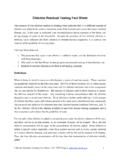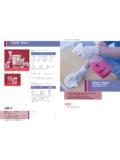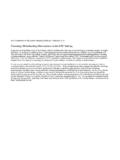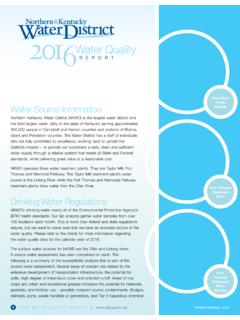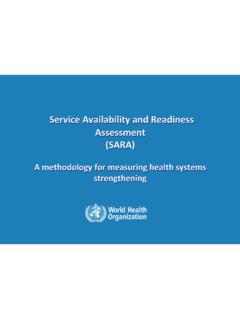Transcription of CITY OF ST. LOUIS - stlwater.com
1 1 city OF ST. LOUIS Water Quality Report 2017 In compliance with the Safe Drinking Water Act, the city of St. LOUIS Water Division is delivering this Water Quality Report to all its customers who receive water bills. We ask that landlords, employers, and anyone else who receives the water bill for other water users share this report with them. To obtain additional copies, call (314) 771-2255 or view it online at The report summarizes information that your water system collects to comply with regulations, including information on water from the Missouri and Mississippi Rivers, the levels of detected contaminants, and compliance with drinking water rules. ST. LOUIS city WATER-A HISTORY OF EXCELLENCE The Water Division is a branch of the St. LOUIS city government s Department of Public Utilities. Since 1835, we have been dedicated to supplying the highest quality water to our customers.
2 We are proud to say that in 2017, our water met or exceeded the standards set by the Environmental Protection Agency and the Missouri Department of Natural Resources. In fact, we have never violated a water quality regulation in 113 years of testing. Our scientists constantly monitor and test the water for over 150 possible contaminants. We analyze the water where it enters the plant as raw river water, throughout the treatment process, and at multiple points throughout the city . The frequency and thoroughness of these tests exceed federal regulations for water quality monitoring. Water quality monitoring of St. LOUIS city water in 2017 indicated that no compounds were detected above the allowable levels set by federal and state regulations. The city of St. LOUIS Water Division is proud to be a charter member of the Partnership for Safe Water.
3 In 1994, this organization was formed by 187 surface water utilities, several drinking water organizations, including the American Water Works Association and the Environmental Protection Agency. The Partnership s goal is to provide a new measure of safety to millions of Americans by improving water quality nationwide. WHERE DOES THE WATER COME FROM? The city of St. LOUIS Water Division has two water treatment plants. The Howard Bend Plant draws water from the Missouri River. The Chain of Rocks Plant is located on the Mississippi River, south of the confluence of the Missouri and Mississippi Rivers. The water reaching our intakes at the Chain of Rocks Plant is primarily Missouri River water because the two rivers have not fully mixed when the water reaches the plant. Together, the two plants produce an average of 135 million gallons of water each day.
4 2 SOURCE WATER ASSESSMENT INFORMATION In 2004, the Missouri Department of Natural Resources (DNR) conducted a source water assessment to determine susceptibility of our source water to contamination. You can acquire the complete results by calling DNR at 1-800-361-4827 or from the internet at Our system is: 6010715. The assessment has determined that our river water source is susceptible due to the presence of potential contaminant sources. The city of St. LOUIS employs all available measures at its disposal to remove contamination at intakes and during the treatment process. The drinking water produced at our facilities consistently meets or exceeds all Safe Drinking Water Standards. WHAT ABOUT CONTAMINANTS? All drinking water, including bottled water, may reasonably be expected to contain at least small amounts of some contaminants.
5 The presence of contaminants does not necessarily indicate that water poses a health risk. More information about contaminants and potential health effects can be obtained by calling the Environmental Protection Agency s Safe Drinking Water Hotline (800-426-4791). GIARDIA AND CRYPTOSPORIDIUM Giardia and Cryptosporidium are microscopic parasites that, when ingested, can result in fever, diarrhea, and other gastrointestinal complications. These organisms are found in all rivers and streams and come from animal wastes in the watershed. They are removed by effective treatment including deactivation with chlorine and precipitative softening, sedimentation, flocculation and filtration. Previous monitoring performed monthly did not detect any Cryptosporidium or Giardia in samples collected after the first stage of our multi-stage, multiple barrier treatment process at either of the city s water purification plants.
6 Prior monitoring showed that neither cysts nor oocysts were detected in our finished water. HEALTH RISKS Some people may be more vulnerable to contaminants in drinking water than the general population. Immuno-compromised persons can be particularly at risk from infections; such as persons with cancer undergoing chemotherapy, persons who have undergone organ transplants, people with HIV/AIDS or other immune system disorders, some elderly individuals, and infants. These people should seek advice about drinking water from their health care providers. EPA/Center for Disease Control guidelines on appropriate means to lessen the risk of infection by Cryptosporidium are available from the Safe Drinking Water Hotline (800-426-4791). 3 LEAD IN DRINKING WATER The city of St. LOUIS Water Division has optimized its treatment process so that the corrosion of internal plumbing is highly unlikely.
7 However, if present, elevated levels of lead can cause serious health problems, especially for pregnant women and young children. Lead in drinking water is primarily from materials and components associated with service lines and home plumbing. The city of St. LOUIS Water Division is responsible for providing high quality drinking water, but cannot control the variety of materials used in plumbing components. When your water has been sitting for several hours, you can minimize the potential for lead exposure by flushing your tap for 30 seconds to 2 minutes before using water for drinking or cooking. If you are concerned about lead in your water, you may wish to have your water tested. Information on lead in drinking water, testing methods, and steps you can take to minimize exposure is available from the Safe Drinking Water Hotline or at FLUORIDATION Since 1953, in accordance with St.
8 LOUIS city Revised Code Chapter , the city of St. LOUIS Water Division has been fluoridating our customer's drinking water. Our goal was to provide fluoridated drinking water to a target level of 1 mg/L. In December 2010, the United States Department of Health and Human Services released a report recommending that fluoridation levels in drinking water should be set at mg/L. In January 2012, the city of St. LOUIS Water Division under the direction of the city of St. LOUIS Health Department reduced the fluoridation goal to mg/L. READING THE TABLES The first table reports only regulated substances that have been found in measurable quantities in St. LOUIS city s finished drinking water. While we test for 150 possible contaminants, traces of only 16 were detected in 2017. The results of the detected contaminants are listed in the table.
9 All contaminants were detected in concentrations well below safe and acceptable limits. The second table lists non-regulated substances whose concentrations have been of interest by consumers. 4 DATA FOR 2017 WATER QUALITY REPORT - city of St. LOUIS Water Division - MO6010715 Detected Contaminants (units) MCL MCLG Maximum Level Detected Range Major Sources of Contaminants Inorganic Compounds Antimony (Total, g/L) 6 6 Discharge from petroleum refineries; fire retardants; ceramics; electronics; solder Arsenic ( g/L) 10 0 Erosion of natural deposits Barium (mg/L) 2 2 Erosion of natural deposits Chromium (Total, g/L) 100 100 Erosion of natural deposits, Industrial discharge Selenium ( g/L) 50 50 Erosion of natural deposits, Industrial discharge Fluoride (mg/L) 4 4 Water additive for dental health Nitrate+Nitrite (as mg/L N) 10 10 Natural Deposits.
10 Fertilizer runoff Lead ( g/L)* AL = 15 0 90th Percentile = Number of samples above AL=0 Corrosion of household plumbing Copper (mg/L)* AL = 90th Percentile = Number of samples above AL=0 Corrosion of household plumbing Organic (Synthetic) Compounds Atrazine ( g/L) 3 3 ND Herbicide runoff from row crops Disinfectant/Disinfection Byproducts Chloramine (mg/L) MRDL = 4 MRDLG = 4 Disinfectant used to treat water Total Trihalomethanes ( g/L) 80 N/A By-product of disinfection Haloacetic Acids (5) ( g/L) 60 N/A By-product of disinfection Microbiological Data Total Coliform Bacteria (% positive samples) 5% of monthly samples positive 0 Highest Month: Annual Average: Naturally present in the environment Total Organic Carbon (mg/L) TT (Required min. 15% TOC removal from source water) N/A Naturally present in the environment Annual Avg.

